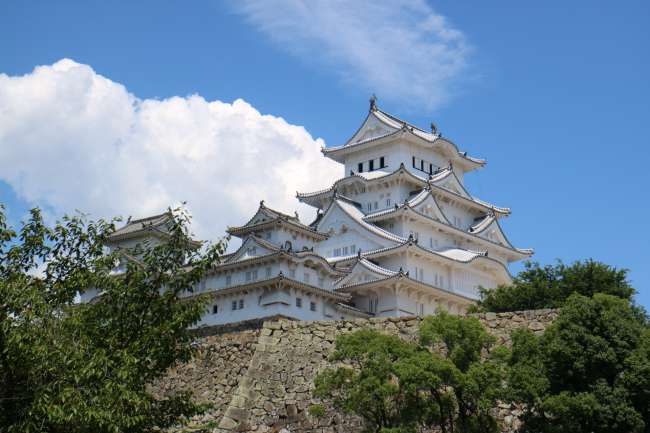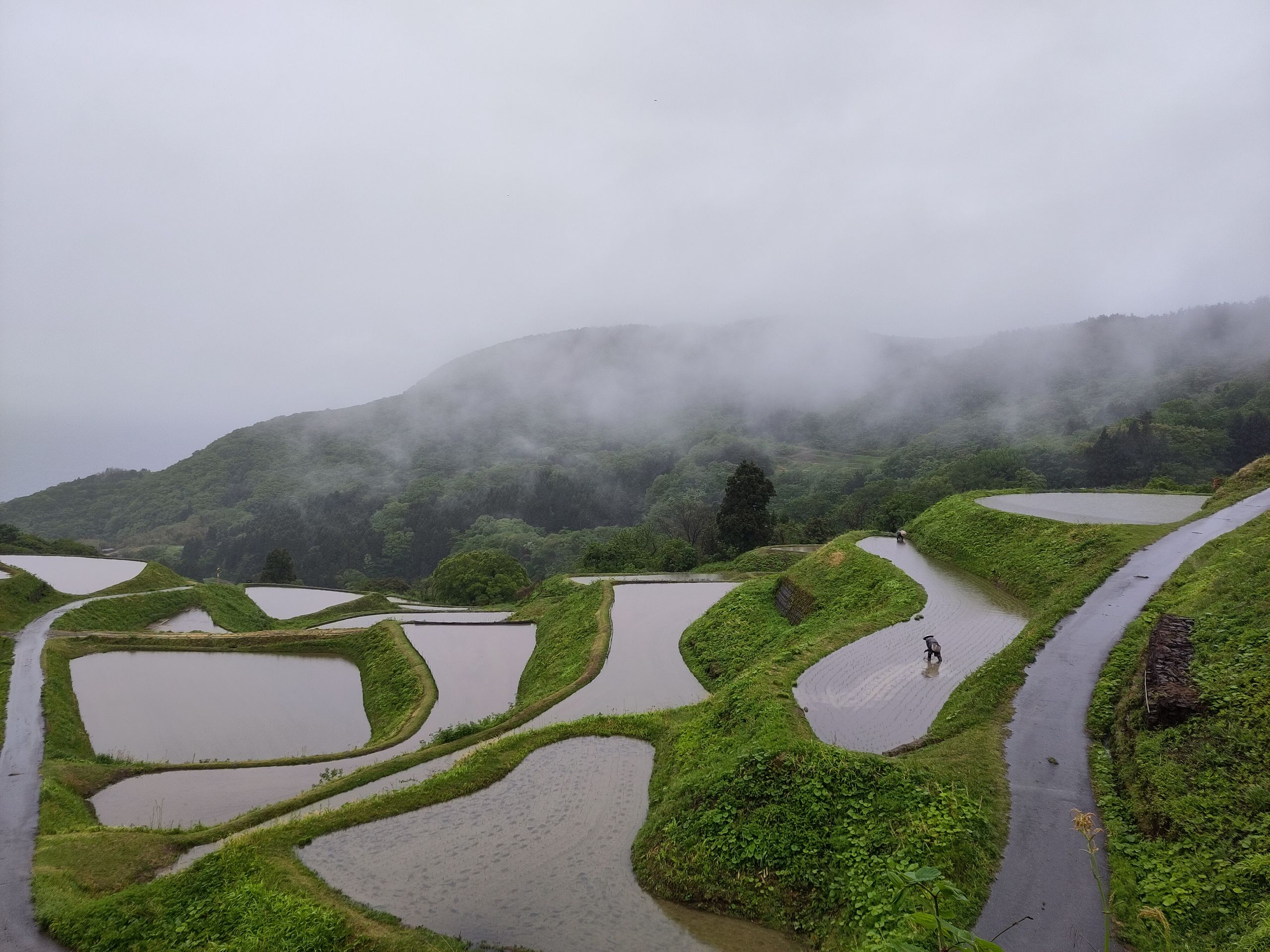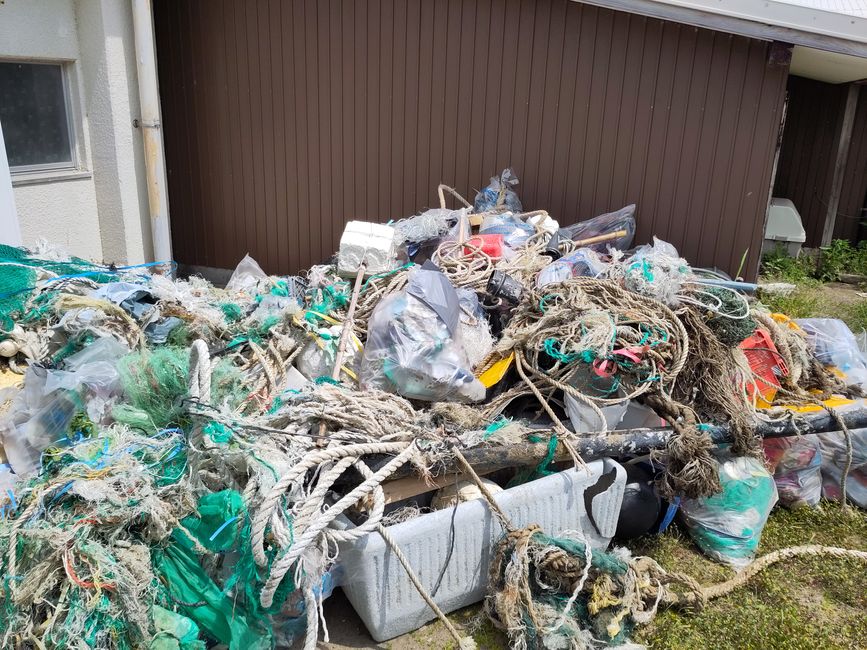Sado - Beach Cleanup (english)
उजवाडाक आयलां: 27.05.2023
The school class from Tokyo has its last day today, and before they leave, we take advantage of the morning to clean up a beach. It's one of the places we visited two days ago and has the most plastic waste. We divide ourselves into groups of six, and each group forms a pile with the collected trash. In the end, the group with the largest pile will receive a reward. We are also instructed to pay attention to the labels on the objects to determine their origin. Items that we find particularly interesting are set aside to show them later in a discussion round.
There is a lot of trash on the beach, so much that we can't clean it completely. Many plastic pieces are buried under the sand and not visible, some parts crumble into tiny pieces when lifted. And much of it is already mixed with the sand, impossible to collect as microplastics spread all over the beach. Sometimes you pull on a small piece of string and end up holding a 2-meter-long, 20-centimeter-thick rope in your hand.
For one hour, we collect everything we can see and grab. When the time is up, we gather at the staircase leading down to the beach to inspect our piles of trash. The teachers conclude that it's impossible to determine a winner because the amount of collected trash doesn't necessarily correspond to the size of the pile, given the variety of objects with different sizes. They say the true winner is the beach since a clear difference can be seen compared to before. In the discussion round, one person from each group shares what they have noticed. Most everyday items come from Japan, South Korea, China, and occasionally Russia, the countries closest to us. But we also find things that come from farther away, including a hazardous materials container from Germany. Recycled waste is also not in short supply. This shows that recycling unfortunately doesn't solve the problem. I didn't understand this fact for a long time myself. Yes, recycling gives plastic a second chance and initially prevents it from entering the environment. But it also gives it a second chance to end up in the ocean. For plastic waste, there are only two destinations: incineration or the environment, often the sea. However, at least half of the waste doesn't come from bottles, flip-flops, toothbrushes, or packaging but from fishing. Buoys, nets, ropes, hooks, and funnel-like sieves make up a large portion of the found items. They get lost at sea, and nobody cares about what happens to them afterward. Yet, the nets, which are intended for catching fish, continue to harm marine life. Eventually, they, like the rest of the plastic waste, break down into microplastics. Fish and other animals then consume them, and we eat those animals.
After going through the piles of trash, we carry everything to the roadside, where we form a large heap that will be collected by the waste disposal and subsequently incinerated. It's time for the school class to return home, and the remaining participants have the afternoon off. We sit in the sun for another hour and enjoy a (relatively) clean stretch of beach.
There is a lot of trash on the beach, so much that we can't clean it completely. Many plastic pieces are buried under the sand and not visible, some parts crumble into tiny pieces when lifted. And much of it is already mixed with the sand, impossible to collect as microplastics spread all over the beach. Sometimes you pull on a small piece of string and end up holding a 2-meter-long, 20-centimeter-thick rope in your hand.
For one hour, we collect everything we can see and grab. When the time is up, we gather at the staircase leading down to the beach to inspect our piles of trash. The teachers conclude that it's impossible to determine a winner because the amount of collected trash doesn't necessarily correspond to the size of the pile, given the variety of objects with different sizes. They say the true winner is the beach since a clear difference can be seen compared to before. In the discussion round, one person from each group shares what they have noticed. Most everyday items come from Japan, South Korea, China, and occasionally Russia, the countries closest to us. But we also find things that come from farther away, including a hazardous materials container from Germany. Recycled waste is also not in short supply. This shows that recycling unfortunately doesn't solve the problem. I didn't understand this fact for a long time myself. Yes, recycling gives plastic a second chance and initially prevents it from entering the environment. But it also gives it a second chance to end up in the ocean. For plastic waste, there are only two destinations: incineration or the environment, often the sea. However, at least half of the waste doesn't come from bottles, flip-flops, toothbrushes, or packaging but from fishing. Buoys, nets, ropes, hooks, and funnel-like sieves make up a large portion of the found items. They get lost at sea, and nobody cares about what happens to them afterward. Yet, the nets, which are intended for catching fish, continue to harm marine life. Eventually, they, like the rest of the plastic waste, break down into microplastics. Fish and other animals then consume them, and we eat those animals.
After going through the piles of trash, we carry everything to the roadside, where we form a large heap that will be collected by the waste disposal and subsequently incinerated. It's time for the school class to return home, and the remaining participants have the afternoon off. We sit in the sun for another hour and enjoy a (relatively) clean stretch of beach.
जाप

प्रवास अहवाल जपानांत


